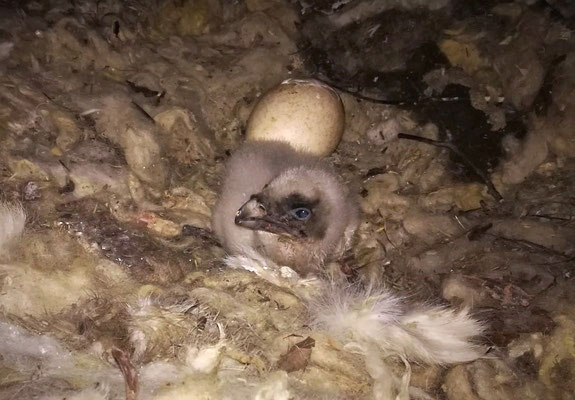
The first 2021 releases of captive-bred Bearded Vultures into the wild already took place! This past Sunday, on 25 Aril, the LIFE GypConnect team released two young Bearded Vultures in the Grands Causses Regional Natural Park as part of the project’s reintroduction efforts!
Get to know the released Bearded Vultures
The young Bearded Vultures are actually brothers. They arrived early this winter at the Richard Faust Bearded Vulture Specialised Captive Breeding Centre (RFZ) in Austria, which is part of the Bearded Vulture Captive Breeding Network, coordinated by the Vulture Conservation Foundation (VCF) on behalf of EAZA’s EEP. The first chick hatched on 23 January and was Europe’s first Bearded Vulture chick of 2021, and his brother a few days later on 1 February. Their dad hatched in 1989 and is a Cretan descendant, while their mother hatched in 1992. Both parents had different partners in the past, but ever since they formed a pair in 2001, they have been very productive breeding birds. A few days after they hatched, the chicks were adopted by different Bearded Vultures at RFZ to ensure natural rearing, making them suitable for release and life in the wild. Now, after approximately three months, the two brothers baptised ‘Plumet’ and ‘Parpaillou’ by school children were ready for freedom!
Release of the captive-bred Bearded Vultures

The LIFE GypConnect team received the two birds this past Sunday. Ahead of their release, the team fitted them with identification rings, bleached a unique set of feather and equipped GPS transmitters on their backs in order to recognise them and monitor their progress in the wild. Then, the team released the young vultures using the ‘hacking method’, which is more or less the natural way of fledging. This method involves releasing nestlings that hatched in captivity at an artificial nest in suitable habitat to acclimatise to the natural environment before they take their first flights. With this technique, the nestlings are able to associate the place where they are released with the area of hatching so that when they reach breeding age, which is around 8-10 years old, they select these places to breed. For the first few months after the release, an attentive team also closely monitors the new inhabitants and their daily progress to help ensure their wellbeing.
In the Grands Causses, 25 Bearded Vultures have already been released. These two new individuals, play a key part in the LIFE GypConnect’s efforts to reintroduce a core population of the species in the Massif Central, and to promote the link between the Bearded Vultures of the Alps and the Pyrenees.
Sign up to our newsletter and never miss any vulture news!
LIFE GypConnect

Led by the League pour la Protection des Oiseaux (LPO), the LIFE GYPCONNECT project aims to establish a breeding population of Bearded Vultures in the Massif Central and Department of the Drôme. Releasing captive-bred Bearded Vultures into the wild at sites such as the Parc Naturel Régional des Grands Causses, Parc Naturel Régional des Baronnies Provençales and Parc Naturel Régional du Vercors will create a core population that will connect the two populations of the species in the Alps and Pyrenees. To facilitate movements between the new population and the Alpine and Pyrenean populations the LIFE GYPCONNECT team is creating a network of supplementary feeding stations, and tackling threats such as poisoning, and collision and electrocution with the electricity infrastructure.






